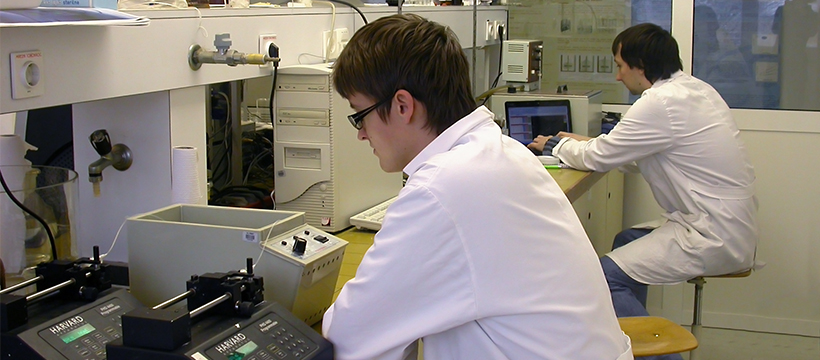
Downstream Processes
Liquid-liquid extraction with organic solvents
The continuous ethyl acetate extraction of progesterone and 11α-hydroxyprogesterone, a reactant and the product of the biotransformation step involved in corticosteroid production, was studied in a microchannel at different flow velocities. In addition, non-steady state batch extraction without mixing was performed and modelled in order to verify the theoretically predicted parameters. In order to analyze experimental data and to forecast microreactor performance, a three-dimensional mathematical model with convection and diffusion terms was developed considering the velocity profile for laminar flow of two parallel phases in a microchannel at steady-state conditions. For the numerical solution of a complex equation system, nonequidistant finite differences were used. Very good agreement between model calculations and experimental data was achieved without any fitting procedure. Due to the efficient phase separation and high extraction yields obtained, the micro scale extraction units were found to be a promising tool for the development of an integrated system of 11α-hydroxylation of progesterone by Rhizopus nigricans in the form of pellets.
Žnidaršič-Plazl, P., I. Plazl. Steroid extraction in a microchannel system: mathematical modelling and experiments. Lab Chip, 2007, 7: 883-889. doi: 10.1039/B704432A
Aqueous two-phase extraction (ATPE)
Aqueous two-phase systems (ATPS) are used as liquid-liquid extraction system for biological compounds, mainly macromolecules such as proteins and nucleic acids. The main advantages of aqueous two-phase extractions are scaling up feasibility, ease of continuous process operation, lower interfacial tension, high protein capacity, non-denaturing solvent environment and high selectivity and biocompatibility. The aim of our study is to utilize the benefits of microstructured devices such as high area/volume ratio for effective aqueous two-phase extraction based on PEG/salt (e.g. K2HPO4, KH2PO4, Na2SO4, etc.) or ionic liquid/sugar or sugar systems. A parallel laminar flow within a microchannel is providing an effective platform to enhance mass transfer and preserve separate phases simultaneously.
The main goal of this study is to identify the limiting steps of protein extraction in ATPS such as partitioning or mass transfer resistance, and to relate these with operational variables such as molecular weight of PEG, PEG and salt concentrations, protein concentration loading, pH, ionic strength, flow rates of both phases, temperature, PEG phase recirculation, etc.
The information derived from this research will help to provide more widely applicable guidelines for the implementation of microreactor technology into bioproduct downstream processes.
